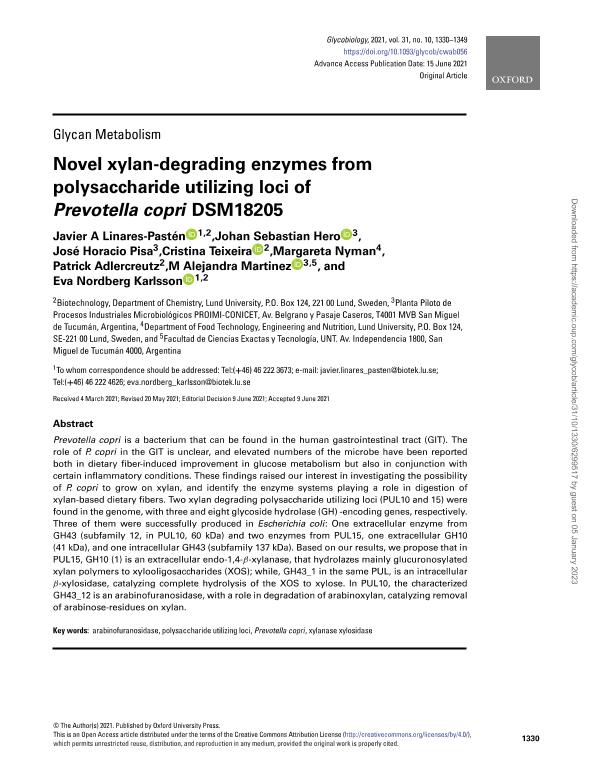Mostrar el registro sencillo del ítem
dc.contributor.author
Linares Pastén, Javier A.
dc.contributor.author
Hero, Johan Sebastian

dc.contributor.author
Pisa, José Horacio

dc.contributor.author
Teixeira, Cristina
dc.contributor.author
Nyman, Margareta
dc.contributor.author
Patrick Adlercreutz
dc.contributor.author
Martinez, Maria Alejandra

dc.contributor.author
Nordberg Karlsson, Eva

dc.date.available
2021-02-26T16:29:18Z
dc.date.issued
2020-12
dc.identifier.citation
Linares Pastén, Javier A.; Hero, Johan Sebastian; Pisa, José Horacio; Teixeira, Cristina; Nyman, Margareta; et al.; Novel xylan degrading enzymes from polysaccharide utilizing loci of Prevotella copri DSM18205; Cold Spring Harbor Laboratory Press; bioRxiv; 12-2020
dc.identifier.issn
2692-8205
dc.identifier.uri
http://hdl.handle.net/11336/126795
dc.description.abstract
Prevotella copri DSM18205 is a bacterium, classified under Bacteroidetes that can be found in the human gastrointestinal tract (GIT). The role of P. copri in the GIT is unclear, and elevated numbers of the microbe have been reported both in dietary fiber-induced improvement in glucose metabolism but also in conjunction with certain inflammatory conditions. These findings raised our interest in investigating the possibility of P. copri to grow on xylan, and identify the enzyme systems playing a role in digestion of xylan-based dietary fibers in P. copri, which currently are unexplored. Two xylan degrading polysaccharide utilizing loci (PUL10 and 15) were found in the genome, with three and eight GH-encoding genes, respectively. Three of the eight gene products were successfully produced in Escherichia coli: One monomeric two-domain extracellular enzyme from GH43 (subfamily 12, in PUL10, 60 kDa) and two dimeric single module enzymes from PUL15, one extracellular GH10 (41 kDa), and one intracellular GH43 subfamily 1 enzyme (37 kDa). The GH43_12 enzyme was hydrolysing arabinofuranose residues from different substrates, and a model of the 3D-structure revealed a single arabinose binding pocket. The GH10 (1) and GH43_1 are cleaving the xylan backbone. Hydrolysis products of GH10 (1) were DP2-4, and seven subsites (−3 to +4) were predicted in the 3D-model of the GH10 active site. GH43_1 mainly produced xylose (in line with its intracellular location). Based on our results we propose that in PUL15, GH10 (1) is an extracellular endo-1,4-β-xylanase, that hydrolyses mainly glucuronosylated xylan polymers to xylooligosaccharides (XOS); while, GH43_1 in the same PUL, is an intracellular β-xylosidase, catalysing complete hydrolysis of the XOS to xylose. In PUL10, the characterized GH43_12 is an arabinofuranosidase, with a role in degradation of arabinoxylan, catalysing removal of arabinose-residues on xylan polymers.
dc.format
application/pdf
dc.language.iso
spa
dc.publisher
Cold Spring Harbor Laboratory Press
dc.rights
info:eu-repo/semantics/openAccess
dc.rights.uri
https://creativecommons.org/licenses/by-nc-sa/2.5/ar/
dc.subject
POLYSACCHARIDE UTILIZING LOCI
dc.subject
PREVOTELLA COPRI
dc.subject
XYLANASE
dc.subject
XYLOSIDASE
dc.subject
ARABINOFURANOSIDASE
dc.subject
GH43
dc.subject
GH10
dc.subject.classification
Biología Celular, Microbiología

dc.subject.classification
Ciencias Biológicas

dc.subject.classification
CIENCIAS NATURALES Y EXACTAS

dc.subject.classification
Bioprocesamiento Tecnológico, Biocatálisis, Fermentación

dc.subject.classification
Biotecnología Industrial

dc.subject.classification
INGENIERÍAS Y TECNOLOGÍAS

dc.subject.classification
Bioquímica y Biología Molecular

dc.subject.classification
Ciencias Biológicas

dc.subject.classification
CIENCIAS NATURALES Y EXACTAS

dc.title
Novel xylan degrading enzymes from polysaccharide utilizing loci of Prevotella copri DSM18205
dc.type
info:eu-repo/semantics/article
dc.type
info:ar-repo/semantics/artículo
dc.type
info:eu-repo/semantics/publishedVersion
dc.date.updated
2021-01-18T20:58:05Z
dc.journal.pais
Estados Unidos

dc.journal.ciudad
Laurel Hollow
dc.description.fil
Fil: Linares Pastén, Javier A.. Lund University. Biotechnology Department; Suecia
dc.description.fil
Fil: Hero, Johan Sebastian. Consejo Nacional de Investigaciones Científicas y Técnicas. Centro Científico Tecnológico Conicet - Tucumán. Planta Piloto de Procesos Industriales Microbiológicos; Argentina
dc.description.fil
Fil: Pisa, José Horacio. Consejo Nacional de Investigaciones Científicas y Técnicas. Centro Científico Tecnológico Conicet - Tucumán. Planta Piloto de Procesos Industriales Microbiológicos; Argentina
dc.description.fil
Fil: Teixeira, Cristina. Lund University. Biotechnology Department; Suecia
dc.description.fil
Fil: Nyman, Margareta. Department Food Technology, Engineering And Nutrition; Suecia
dc.description.fil
Fil: Patrick Adlercreutz. Lund University. Biotechnology Department; Suecia
dc.description.fil
Fil: Martinez, Maria Alejandra. Consejo Nacional de Investigaciones Científicas y Técnicas. Centro Científico Tecnológico Conicet - Tucumán. Planta Piloto de Procesos Industriales Microbiológicos; Argentina. Universidad Nacional de Tucumán. Facultad de Ciencias Exactas y Tecnología; Argentina
dc.description.fil
Fil: Nordberg Karlsson, Eva. Lund University. Biotechnology Department; Suecia
dc.journal.title
bioRxiv
dc.relation.alternativeid
info:eu-repo/semantics/altIdentifier/doi/https://doi.org/10.1101/2020.12.10.419226
dc.relation.alternativeid
info:eu-repo/semantics/altIdentifier/url/https://www.biorxiv.org/content/10.1101/2020.12.10.419226v1
Archivos asociados
